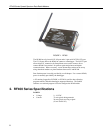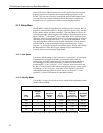
RF400 Series Spread Spectrum Data Radio/Modems
10
4.1.3.2 ATDT Command Mode
This mode is not required for basic point-to-point communication.
For point-to-multipoint operation the RF400 can temporarily be put into AT
Command Mode by sending a string of three ASCII characters. The default
sequence to enter AT Command mode is:
1. No characters sent for one second (before command character)
2. “+++”characters sent (default command mode entry character)
3. No characters sent for one second (after command mode character)
4. RF400 responds by sending “OK” <CR>
The AT Command mode characters are sent by PC208W along with other
commands to change the base RF400’s Radio Address to talk to the desired
remote RF400 (see point-to-multipoint example in Software Setup Section).
4.1.3.3 Combination Mode Communications
Besides the “direct” to PC communications described in the Quick Start and
Installation sections, it is possible to combine methods in datalogger
communications. Some examples:
• Phone to RF400: PC to external modem to COM210 w/PS512M to RF400
to datalogger (see Appendix I)
• Short Haul modem to RF400: PC to short haul modems to RF400s to
datalogger (see Appendix G)
• Network to RF400: PC to Internet to NL100 to RF400 to datalogger (use
LoggerNet IPPort or PC208W socket, remote IP address, port number)
4.1.4 Error Handling and Retries
In the RF module received packets are analyzed for data corruption with an
embedded CRC. The RF400 rejects a received packet (doesn’t send it out a
port) if the packet’s header address fails to match the RF400 address, if an RF
module receive error is detected, or if the RF packet’s CRC test fails.
In early RF400s no notification was given when a packet was rejected, and
there were no retries nor guaranteed delivery of packets. Retries were handled
by protocols in LoggerNet and PC208W. Starting with SW Version 6.420 the
RF400 series radios themselves are capable of doing retries in a network with
an unlimited number of array-based stations or in a network consisting of two
PakBus stations.
4.1.4.1 Standard Retry Levels
There are four pre-programmed Retry Levels available in the Standard Setup
menu. All RF400s in the network should be configured for the same Retry
Level. The default setting is “None.” The standard settings should satisfy
most application requirements. Further choices are available in the Advanced
Setup menu. All radios in a network should have the same “Maximum


















